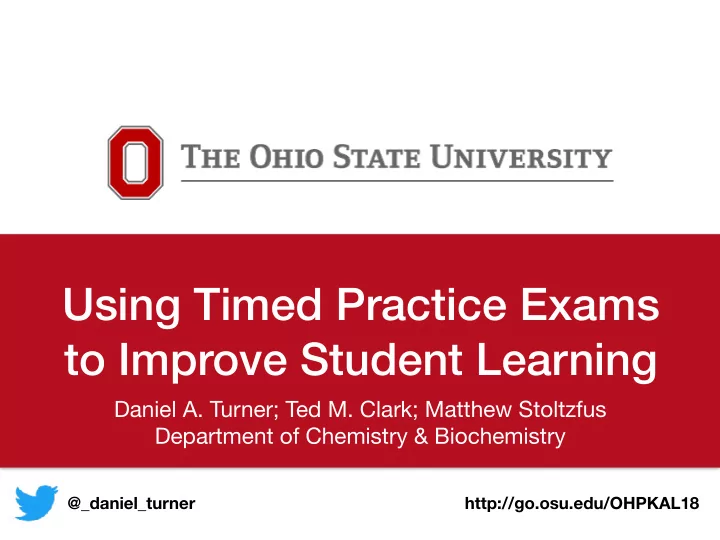

Using Timed Practice Exams to Improve Student Learning Daniel A. Turner; Ted M. Clark; Matthew Stoltzfus Department of Chemistry & Biochemistry @_daniel_turner http://go.osu.edu/OHPKAL18
Objectives of Talk • Introduce evidence-based practices to support ideas behind practice exams. • Discuss the development and delivery of timed practice exams. • Present the results and overall findings through two versions of practice exams. • A PDF file of this talk (and other resources) can be found at go.osu.edu/OHPKAL18 � 2
What are the pros and cons of providing practice exams to students? � 3
Ebbinghaus Forgetting Curve � 4
Testing Effect • Students studied prose passages • After – combination of free-recall tests (no feedback) and/or restudied the material. • Final retention tests: • 5 minutes later • 1 week later • Assessment produced substantially greater retention! Roediger, H.L., III, & Karpicke, J.D. (2006). Psychol. Sci. , 17 , 249–255. 5
Distributed Practice • Interleaving (ABCABCABC) vs. blocking (AAABBBCCC) • 4 experiments that tested how well students recalled organic compounds. • In all 4 cases, interleaving was shown to be more beneficial than blocking. Eglington, L. G., & Kang, S.H.K. (2017). J. Appl. Res. Mem. Cogn. , 6 , 475–485. 6
Retrieval Practice • Bringing learned information to mind from long-term memory – this is simply the testing e ff ect! • How can we implement this in our classes? • One of the best methods is to use frequent low-stakes or no- stakes quizzes. • Wanting to combine this with distributed practice, I looked toward low-stakes practice exams. � 7
Motivation for Timed Practice Exams • With a time constraint, students need to • eliminate choices and make a guess when needed. • work problems at a faster rate. • determine when to move on for challenging problems. • Emphasize the metacognitive application! • Focus remaining study time on areas of weakness, instead of areas of strength. � 8
Version 1.0 (Fall 2017) • Delivered 1 practice exam in class: • Exam delivered via Learning Catalytics. • 55-minute multiple-choice exam (actual exam = 75 minutes). • No feedback, correct answers provided after class was over. • 3 days before exam. � 9
Practice Exam Question � 10
Actual Exam Question A. 72% B. 10% C. 9% D. 9% The % correct for the entire 1210 sequence was 64%. Is this significant? � 11
Practice Exam Question � 12
Actual Exam Question A. 2% B. 2% C. 93% D. 2% Significant increase – but the question is structured di ff erently. � 13
Version 2.0 (Spring 2018) • For each actual exam, Dr. Clark and Dr. Stoltzfus delivered 3 practice exams outside of class: • Exam delivered via Mastering Chemistry • Multiple-choice exams of varying times (30-75 minutes) • Embedded feedback (for both correct and incorrect answers) provided after the deadline. • Delivered at various times before the exam. � 14
The Value of Feedback Butler, A. C. & Roediger, H.L., III (2008). Mem. Cogn. , 36 , 604–616. 15
Practice Exam Question � 16
Practice Exam Question – Feedback � 17
Actual Exam Question • We gave this same question on an exam the previous semester. • 55% of students answered this question correctly. • What does this mean? � 18
Comparison of Practice vs. Actual Exam Practice exam – 50% correct Actual exam – 57% correct • The questions are very similar – why did the percentage only go up 7%? � 19
Overall Findings/Conclusions • When the practice exam was the previous semester’s exam, the results were very similar – encouraging at this point. • This suggests the students are taking the practice exams seriously. • The transfer of knowledge between a concept covered on the practice exam to the actual exam is unclear. • There are too many variables to sort this out using our current methodology. • This process has also helped improve our common exam creation. � 20
Questions? � 21
Recommend
More recommend